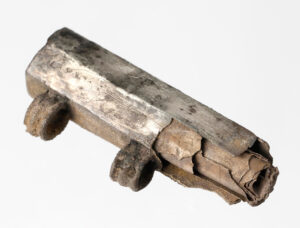A silver foil with a written inscription in Latin was found while excavating a cemetery in the town of Nida, a suburb of Frankfurt, Germany. It was contained in a small silver amulet, just over an inch tall, that had been buried around its owner’s neck.
The foil was too poorly preserved to unroll but with the use of CT scans and computer tomography the inscription was revealed. Consisting of eighteen lines, the inscription reads (in part):
Holy, holy, holy! In the name of Jesus Christ, Son of God! …This rescue device(?) protects the person who surrenders to the will of the Lord Jesus Christ, the Son of God, since before Jesus Christ bend all knees: the heavenly ones, the earthly and the subterranean, and every tongue confess (to Jesus Christ).

The silver amulet, less than 1.5” in diameter, worn around the neck, contained a roll of thin silver foil.
Dating to AD 230-270, this discovery is significant because it is the earliest certain physical evidence of the spread of Christianity north of the Alps. The latter part of the inscription is clearly a reference to Philippians 2:10-11.
According to the Bible, the spread of the Christian faith into Europe may have taken place already in the first century A.D. The apostle Paul states his intent to take the Gospel to Spain in the mid-60s (Romans 15:24, 28). However, the completion of that mission was not recorded in Scripture, leaving it uncertain. Early church fathers Cyril of Jerusalem, Jerome, and Chrysostom all state that it did occur.
Source: “Evidence of Early Christianity in Northern Europe.” Nathan Steinmeyer. Bible History Daily from Biblical Archaeology Society, January 3, 2025.




Leave a Reply